Hydrogen Storage Market Research, 2032
The global hydrogen storage market was valued at $2.8 billion in 2022, and is projected to reach $8.6 billion by 2032, growing at a CAGR of 12.7% from 2023 to 2032.
Report Key Highlighters
- The report provides competitive dynamics by evaluating business segments, product portfolios, target market revenue, geographical presence and key strategic developments by prominent manufacturers.
- The hydrogen storage market is fragmented in nature among prominent companies such as Air Liquide, Linde Plc, Worthington Industries Inc, Luxfer Holdings PLC, Hexagon Composites ASA, Chart Industries, Inc., INOXCVA, Hbank Technologies Inc., PRAGMA INDUSTRIES and Steelhead Composites.
- The study contains qualitative information such as the market dynamics (drivers, restraints, challenges, and opportunities), key regulation analysis, pricing analysis, and Porter’s Five Force Analysis across North America, Europe, Asia-Pacific, LAMEA regions.
- Latest trends in global hydrogen storage market such as undergoing R&D activities, development of efficient storage vessels, public policies, and government initiatives are analyzed across 16 countries in 4 different regions.
- More than 2,200 hydrogen storage-related product literatures, industry releases, annual reports, and other such documents of key industry participants along with authentic industry journals and government websites have been reviewed for generating high-value industry insights for global hydrogen storage market.
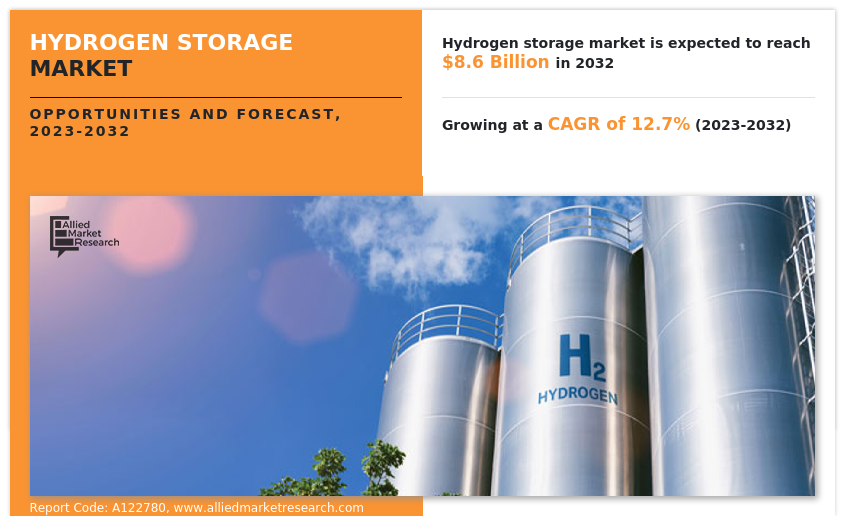
Hydrogen storage is a key enabling technology for the advancement of hydrogen and fuel cell technologies in applications including stationary power, portable power, and transportation. Hydrogen has the highest energy per mass of any fuel; however, its low ambient temperature density results in a low energy per unit volume, therefore requiring the development of advanced storage methods that have potential for higher energy density.
Hydrogen can be stored physically as either a gas or a liquid. Storage of hydrogen as a gas typically requires high-pressure tanks (350–700 bar [5,000–10,000 psi] tank pressure). Storage of hydrogen as a liquid requires cryogenic temperatures because the boiling point of hydrogen at one-atmosphere pressure is −252.8°C. Hydrogen can also be stored on the surfaces of solids (by adsorption) or within solids (by absorption).
High density hydrogen storage is a challenge for stationary and portable applications and remains a significant challenge for transportation applications. Presently available storage options typically require large-volume systems that store hydrogen in gaseous form. This is less of an issue for stationary applications, where the footprint of compressed gas tanks may be less critical. However, fuel-cell-powered vehicles require enough hydrogen to provide a driving range of more than 300 miles with the ability to quickly and easily refuel the vehicle.
These vehicles are expected to rely on compressed gas onboard storage using large-volume, high-pressure composite vessels while some light-duty hydrogen fuel cell electric vehicles (FCEVs) that are capable of this range have emerged onto the market. The required large storage volumes may have less impact on larger vehicles, but providing sufficient hydrogen storage across all light-duty platforms remains a challenge. The importance of the 300-mile-range goal can be appreciated by looking at the sales distribution by range chart on this page, which shows that most vehicles sold today are capable of exceeding this minimum.
On a mass basis, hydrogen has nearly three times the energy content of gasoline—120 MJ/kg for hydrogen versus 44 MJ/kg for gasoline. On a volume basis, however, the situation is reversed; liquid hydrogen has a density of 8 MJ/L whereas gasoline has a density of 32 MJ/L, as shown in the figure comparing energy densities of fuels based on lower heating values. Onboard hydrogen storage capacities of 5–13 kg hydrogen is anticipated to be required to meet the driving range for the full range of light-duty vehicle platforms.
Targeting both near-term and long-term solutions to overcome these challenges HFTO has pursued two strategic pathways. The near-term pathway focuses on compressed gas storage, using advanced pressure vessels made of fiber-reinforced composites that are capable of reaching 700 bar pressure, with a major emphasis on system cost reduction.
The long-term pathway focuses on both (1) cold or cryo-compressed hydrogen storage, where increased hydrogen density and insulated pressure vessels may allow for DOE targets to be met, and (2) materials-based hydrogen storage technologies, including sorbents, chemical hydrogen storage materials, and metal hydrides, with properties having potential to meet DOE hydrogen storage targets.
The global emphasis on sustainable energy sources has put hydrogen to the forefront of potential solutions, leading to a surge in demand. Hydrogen storage, an essential aspect of its practical application, faces both challenges and growth opportunities as the demand increases. This increased demand for hydrogen is fueled by its potential as a clean fuel for transportation, a storage medium for renewable energy, and its role in various industrial processes. Such expansive applications necessitate efficient, safe, and cost-effective hydrogen storage solutions. Research and investment in storage technology have intensified with growth in demand.
Traditional storage methods, such as compressed hydrogen and liquid hydrogen, have their limitations, ranging from safety concerns to the energy-intensive nature of the processes. This drives the exploration of innovative methods such as metal hydrides, chemical hydrogen storage, and sorption-based storage. These technologies, while promising, need to be scaled and optimized for widespread commercial use. Another implication of the increased demand is the need for infrastructure development.
A robust hydrogen economy is expected to require vast storage solutions not only at the point of use, such as fueling stations or power plants, but also in the distribution and transportation networks. This is anticipated to necessitate advancements in portable storage solutions and efficient distribution mechanisms.
However, it is not just about technological innovation. The hydrogen storage market is segmented into type, storage form, end-use industry, and region. On the basis of type, the market is categorized into cylinder, merchant, on-site, and on-board. On the basis of storage form, the market is bifurcated into material-based hydrogen storage and physical hydrogen storage. On the basis of end-use industry, the market is classified into chemical, oil refineries, automotive & transportation, metalworking, and others. On the basis of region, it is analyzed across North America, Europe, Asia-Pacific, and LAMEA.
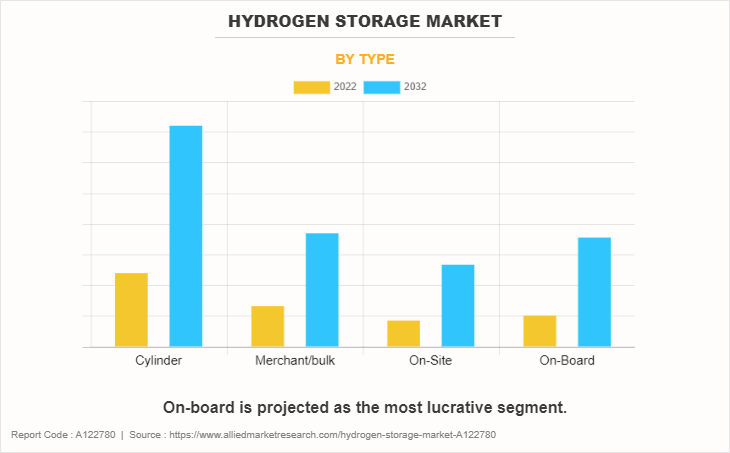
In 2022, the cylinder segment was the largest revenue generator, and is anticipated to grow at a CAGR of 12.5% during the forecast period. The growth in interest in green energy solutions has led to a surge in demand for cylinder hydrogen storage, a method viewed by many as a vital component in the transition to a more sustainable energy future. With the world aggressively moving away from fossil fuels, hydrogen, often hailed as the fuel of the future, finds itself in the spotlight due to its high energy content and clean-burning properties, producing only water as a byproduct. Consequently, effective storage and transport mechanisms for hydrogen have become increasingly crucial, with compressed hydrogen cylinders emerging as a prevalent choice for several reasons.
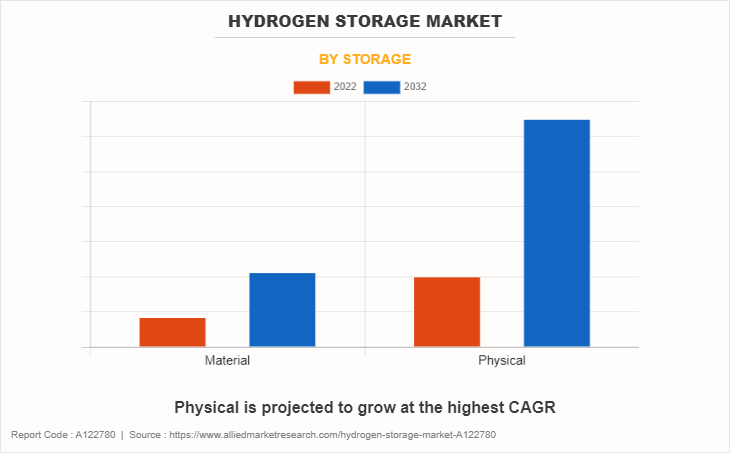
By storage, the physical segment dominated the global market in 2022, and is anticipated to grow at a CAGR of 13.4% during forecast period. Hydrogen is poised to play a significant role in a diverse array of sectors, from transportation to power generation with its potential to be a clean, versatile energy carrier. As such, effective, efficient, and scalable storage solutions are crucial for the broader integration of hydrogen into our energy systems. Compressed hydrogen storage, one of the primary physical methods, leverages mature technology, with tanks designed to handle pressures up to 700 bar. It is the go-to choose for many hydrogen-powered vehicles, with research focusing on developing lighter and stronger composite materials to increase the energy-to-weight ratio of storage systems.
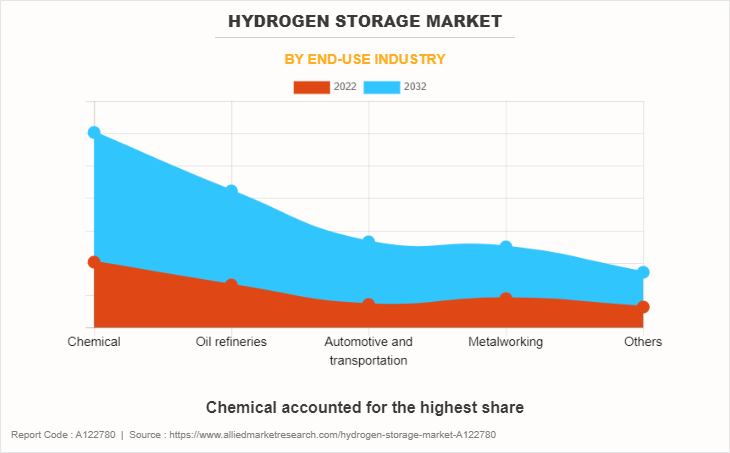
By end-use industry, the chemical segment dominated the global market in 2022, and is anticipated to grow at a CAGR of 12.3% during forecast period. The global chemical industry, central to numerous facets of the modern economy, has experienced an unprecedented uptick in the demand for hydrogen storage. The role of hydrogen as both a reactant and a potential energy vector becomes more pronounced as the sector expands and adapts to evolving technological and environmental paradigms. Key processes such as hydrocracking, ammonia synthesis, methanol production, and desulfurization rely heavily on a steady hydrogen supply. The growth in these areas, combined with an industry-wide transition toward greener practices, has resulted in a pressing need for efficient and scalable hydrogen storage solutions.
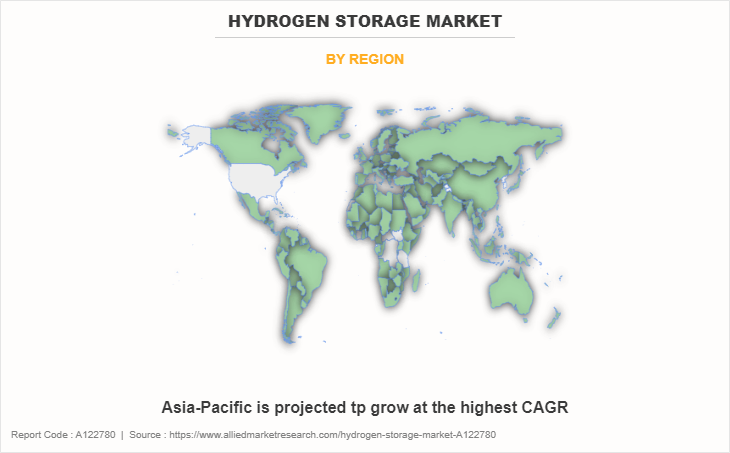
The Asia-Pacific hydrogen storage market size is projected to grow at the highest CAGR of 14.2% during the forecast period of hydrogen storage market share in 2022. Asia-Pacific region, a robust confluence of policy directives, industrial growth, and technological advancements has propelled a pronounced growth in the demand for hydrogen storage solutions. Japan has positioned itself as a front-runner in the global hydrogen economy. Their strategy lays out plans for the importation, storage, and utilization of hydrogen as a primary energy source. Many sectors, from steel production to petrochemicals, have explored hydrogen as an alternative fuel with the growth in emphasis on decarbonizing heavy industries. This drives the need for large-scale, reliable hydrogen storage solutions.
The introduction of hydrogen fuel cell vehicles (FCVs) in the region, especially in countries such as Japan and South Korea, has driven the need for hydrogen refueling stations, which, in turn, requires efficient storage solutions. The Asia-Pacific region, with its combination of policy support, technological innovation, and market potential, is poised to be a major hub for the growth of the hydrogen economy and its associated storage needs in the coming years.
Major players operating in the hydrogen storage market are Air Liquide, Linde Plc, Worthington Industries Inc, Luxfer Holdings PLC, Hexagon Composites ASA, Chart Industries, Inc., INOXCVA, HBank Technologies Inc, PRAGMA INDUSTRIES and Steelhead Composites.
Key Benefits For Stakeholders
- This report provides a quantitative analysis of the market segments, current trends, estimations, and dynamics of the hydrogen storage market analysis from 2022 to 2032 to identify the prevailing hydrogen storage market opportunities.
- The market research is offered along with information related to key drivers, restraints, and opportunities.
- Porter's five forces analysis highlights the potency of buyers and suppliers to enable stakeholders make profit-oriented business decisions and strengthen their supplier-buyer network.
- In-depth analysis of the hydrogen storage market segmentation assists to determine the prevailing market opportunities.
- Major countries in each region are mapped according to their revenue contribution to the global market.
- Market player positioning facilitates benchmarking and provides a clear understanding of the present position of the market players.
- The report includes the analysis of the regional as well as global hydrogen storage market trends, key players, market segments, application areas, and market growth strategies.
Hydrogen Storage Market Report Highlights
| Aspects | Details |
| Market Size By 2032 | USD 8.6 billion |
| Growth Rate | CAGR of 12.7% |
| Forecast period | 2022 - 2032 |
| Report Pages | 270 |
| By Type |
|
| By Storage |
|
| By End-use Industry |
|
| By Region |
|
| Key Market Players | Linde Plc, Luxfer Holdings PLC, Chart Industries, Inc., inoxcva, Air Liquide, Pragma Industries, Steelhead Composites, Inc., HBank Technologies Inc., Hexagon Composites ASA, Worthington Industries Inc. |
Analyst Review
According to the CXOs of the leading companies, as hydrogen becomes a more popular choice for energy and fuel, the demand for efficient storage solutions is expected to skyrocket. Early entrants and innovators in the hydrogen storage market stand to gain significant competitive advantages. For companies already in the energy sector, hydrogen storage offers a promising avenue for diversification, mitigating risks associated with traditional fossil fuel markets.
Current storage methods, be it compression, liquefaction, or solid-state storage, have their limitations. There is a pressing need for R&D investments to innovate and refine these technologies. Strategic investments in R&D can potentially yield breakthroughs in storage efficiency and cost-effectiveness. Collaborations with academic institutions or startups can accelerate innovation. Understanding regional dynamics is crucial.
Increased demand for low-emission fuel and increased demand from various end-use industries are the upcoming trends of the hydrogen storage market.
Chemical the leading application of the hydrogen storage market.
Asia-Pacific is the largest regional market for the hydrogen storage.
The global hydrogen storage market was valued at $2.8 billion in 2022, and is projected to reach $8.6 billion by 2032, growing at a CAGR of 12.7% from 2023 to 2032.
Air Liquide, Linde Plc, Worthington Industries Inc, Luxfer Holdings PLC, Hexagon Composites ASA, Chart Industries, Inc., INOXCVA, HBank Technologies Inc, PRAGMA INDUSTRIES and Steelhead Composites re the top companies to hold the market share in the hydrogen storage market.
Loading Table Of Content...
Loading Research Methodology...



